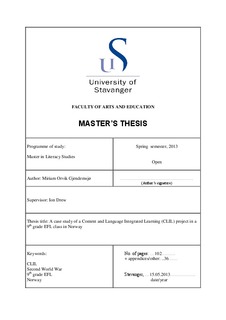| dc.contributor.author | Gjendemsjø, Miriam Orvik | |
| dc.date.accessioned | 2013-10-30T08:47:46Z | |
| dc.date.available | 2013-10-30T08:47:46Z | |
| dc.date.issued | 2013-05-16 | |
| dc.identifier.uri | http://hdl.handle.net/11250/185458 | |
| dc.description | Master's thesis in Literacy Studies | no_NO |
| dc.description.abstract | This thesis is a study of a Content and Language Integrated Learning (CLIL) project in a 9th grade Norwegian EFL class. History, namely the Second World War from the perspective of young people’s experiences, was taught with English as the language of instruction. CLIL is a content-driven approach where the main emphasis is on using a different language than the mother tongue as a tool for teaching and learning about another subject; the focus is on meaning and not the forms of language. CLIL creates a dual benefit of developing both language and content knowledge.
The thesis aimed to investigate the teacher’s motives for initiating the project, the pupils’ and teacher’s expectations, experiences and challenges, and how the project benefited the pupils. It is a case study based on multiple methods. Two pupil questionnaires were used, one in the initial stage of the project and one after the project had ended. Thirteen lessons were observed, including observing the pupils giving oral presentations on topics they had been working on connected to the overall theme. The presentations were recorded and transcribed. In addition, the teacher was interviewed both before the project started and after it had ended and five pupils were also interviewed at the end of the project.
One of the main findings was that the teacher played a central role. The project was implemented on the teacher’s initiative and interest in the topic and her view that textbook-based teaching was too limited. Finding and assessing appropriate materials for a mixed ability class was a major challenge. These included extracts from books written for native-speakers, texts from course books for the age group, and films on the subject. The teacher experienced the project to be generally rewarding for her and beneficial for the pupils. The pupils’ expectations and experiences were mainly positive. For most of the pupils, learning about WWII in English was not regarded as difficult in general, although some of the texts were regarded as difficult. The pupils were mostly focused on the subject matter and not the fact that they were using English to learn about it. The use of films and activities related to them were what they liked most, while giving oral presentations, reading and writing were less popular activities. The project promoted communicative engagement in classroom discussions. Vocabulary connected to the topic was one of the areas in which the pupils developed their language, but most of them did not feel that they had developed their language in other ways.
CLIL has primarily been used at the upper secondary level in Norway. This study has shown that CLIL also has a potential with young Norwegian EFL learners. | no_NO |
| dc.language.iso | eng | no_NO |
| dc.publisher | University of Stavanger, Norway | no_NO |
| dc.relation.ispartofseries | Masteroppgave/UIS-HF-IKS/2013; | |
| dc.subject | literacy studies | no_NO |
| dc.subject | lesevitenskap | no_NO |
| dc.subject | clil | no_NO |
| dc.subject | content and language integrated learning | no_NO |
| dc.subject | second world war | no_NO |
| dc.subject | andre verdenskrig | no_NO |
| dc.subject | 9th grade efl | no_NO |
| dc.subject | engelsk | no_NO |
| dc.subject | Norway | no_NO |
| dc.subject | Norge | no_NO |
| dc.subject | WWII | no_NO |
| dc.subject | world war two | no_NO |
| dc.title | A case study of a content and language integrated learning (clil) project in a 9th grade efl class in Norway | no_NO |
| dc.type | Master thesis | no_NO |
| dc.subject.nsi | VDP::Humanities: 000::Literary disciplines: 040::General literary science: 041 | no_NO |
